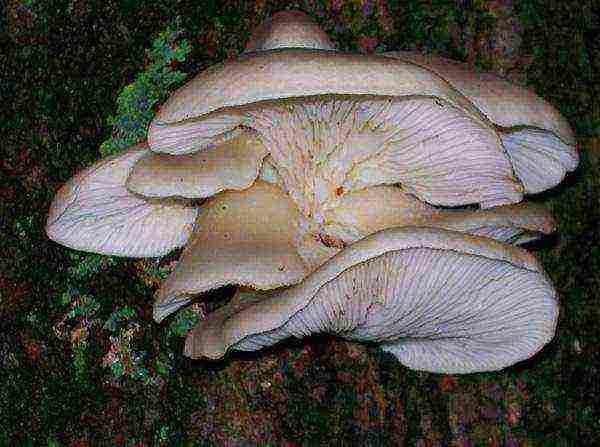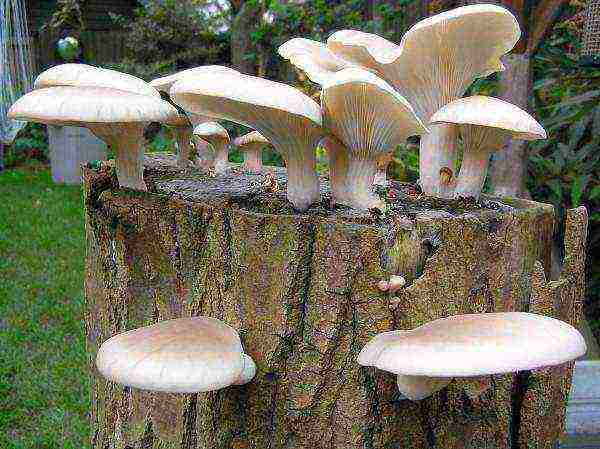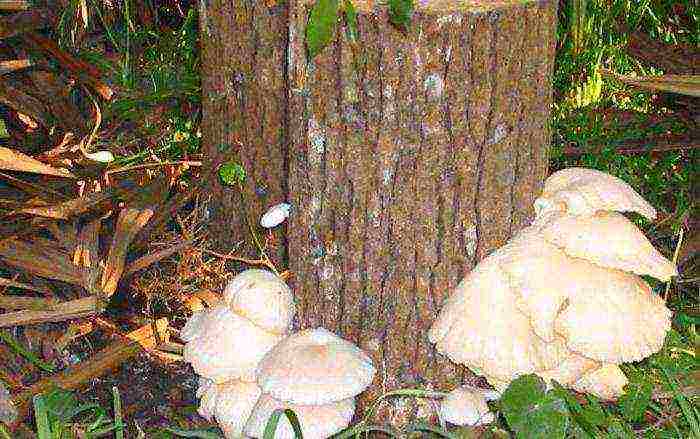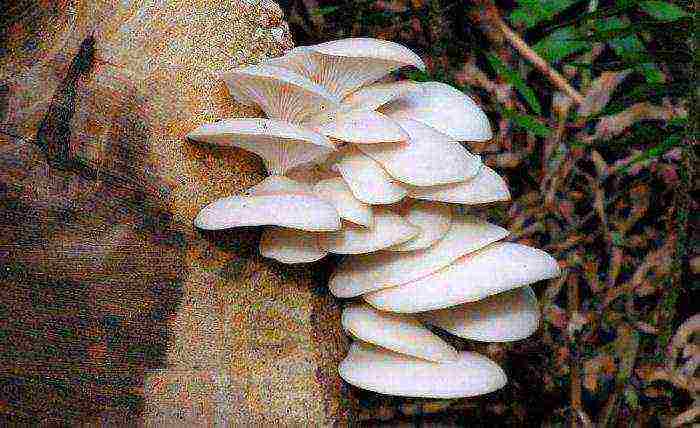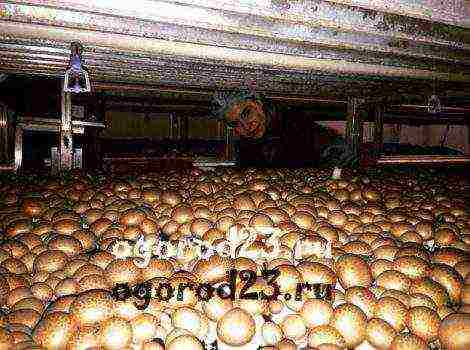Content
In recent years, more and more people have begun to master technologies that allow collecting oyster mushrooms on stumps. Growing these mushrooms at home does not require any special knowledge and skills. After reading this article, you will learn about the main stages of this process.
Mycelium selection
To collect oyster mushrooms on stumps, cultivation must begin with the acquisition of high-quality planting material. Some vendors offer to buy mycelium on sticks. However, long-term practice has shown that when using them, the first harvest can be obtained only after two years, and sometimes even later. Therefore, experts recommend purchasing fresh mycelium from oats or wheat. When choosing such planting material, you must make sure that there is no gray-green mold on it, the excess of which indicates the poor quality of the offered product.
When is it better to plant oyster mushrooms on stumps?
It is advisable to start growing these mushrooms in the autumn months. It is during this period that they do not require frequent watering, and the crop ripens much faster. If, with spring sowing, it will be possible to feast on mushrooms after a year and a half, then with autumn sowing - just a year later. In the first six months, oyster mushrooms require special care, which consists in frequent watering.
All of the above does not mean that you need to abandon the spring sowing of mycelium. It's just that in such cases, the logs with the future harvest are not buried in the ground, but placed in the basement and covered with wet burlap so that they gradually become overgrown with mycelium. In the fall, they are taken out of the cellar and buried in the ground.
Sowing technology
It should be understood that growing oyster mushrooms at home on stumps is a long and laborious process. In this case, you can only get a seasonal harvest, depending on climatic and weather conditions. The preparation of stumps must begin at the end of January. It is advisable to choose those on the surface of which there are no signs of mold. Before adding planting material, the logs should be soaked in water for three days. This will create the increased moisture required for the mycelium to be set. Stumps with mycelium can be taken out into the garden no earlier than May, when the threat of frost will completely disappear.
To get a good harvest of oyster mushrooms on stumps, cultivation and sowing can be carried out in several different ways:
- Holes are made in the logs, the depth of which is about six centimeters, and the diameter is about ten millimeters. Then they are filled with mycelium in grains and covered with moss or scotch tape.
- Planting material is laid out on the end of the stump and covered with a disc previously cut from a log, the thickness of which is about three centimeters, and then fixed with nails.
- A pyramid is built from the chocks, and the end of each log is covered with a two-centimeter layer of mycelium.
After sowing, the stumps are placed in a cellar and covered with burlap or foil.
Growing oyster mushrooms on stumps in the basement
In order for your venture to be crowned with success, it is necessary not only to choose the right mycelium, but also to create optimal conditions in the room chosen for these purposes. It is important that the air temperature in the basement is at least fifteen and no more than twenty degrees, and the humidity is within 80-95%.
It is recommended to pay special attention to ensuring good ventilation and lighting. It should also be understood that growing oyster mushrooms on stumps in the basement implies insulation and re-equipment of the room. To avoid carbon dioxide build-up, it is imperative to install fans.It is advisable to use fluorescent lamps as lighting devices. To place blocks with mushrooms in the basement, special racks should be equipped in advance. It is preferable that they are made of durable plastic that is resistant to moisture.
Open ground transplant
In May, hemp with oyster mushrooms can be moved to the garden. The readiness for landing on open ground can be judged by the presence of a dense white bloom. For the most successful fruiting of myceliums, it is advisable to put the logs in the shade, for example, under densely leafy trees.
Wet leaves are lined at the bottom of the pre-dug pits, and then stumps are planted. It is important that the embedment depth of the logs does not exceed fifteen centimeters. The distance between adjacent chocks should be about half a meter. Further care of the plantings consists in periodically moistening the soil around the logs. The first crop can be harvested at the beginning of autumn.
With the onset of winter, it is recommended to wrap hemp with spruce branches, leaves or straw. A similar mycelium will bear fruit abundantly for several years in a row. The maximum mushroom harvest can be harvested in the second and third years.
It is not difficult to grow oyster mushrooms. I will tell you what conditions are necessary for this.
I harvest healthy hardwood: poplar, aspen, apple, pear, walnut. I saw it into stumps 30-40 cm high and at least 18 cm in diameter. On each one I make sure to make notes (small notches) on the cut, which was on the side of the crown. The bark does not need to be removed. Along the entire lateral surface of the stumps, I drill holes with a diameter of 10-15 mm, a depth of 7-10 cm at a distance of 12-15 cm from each other. I soak the workpieces in water in any container (bath, barrel) for 2-3 days. Fresh wood need not be soaked.
Pick-up location
In a shady, damp place of a garden plot or vegetable garden (it is possible between currant bushes, gooseberries and in a raspberry tree), I dig holes 15-20 cm deep, slightly larger in diameter than hemp. At the same time, it is important to observe the distance between the holes - 30-35 cm. At the bottom of each hoard I put moistened sawdust (or small shavings, straw) with a layer of 1-1.5 cm. On top I pour the planting mycelium of mushrooms with a layer of 1 cm and put the hemp notches up. It is very important.
Growing oyster mushrooms on stumps
The fact is that wood has the ability to absorb water only in the direction from the root to the crown. And if the stump stands incorrectly, "roots" upwards, it will not absorb water from the soil and will give a very small harvest of mushrooms (only one harvest, and in dry weather it may not be at all).
Oyster mushroom growing technology
Before putting the hemp in the hole, I fill the holes drilled in them with planting mycelium and close the outside with wax or corks from wet sawdust. Instead of holes, you can make cuts, slots and fill in the same way.
Around the stumps installed in the holes, I compact the soil - I trample it down with my feet. To save space, wooden blanks can be stacked on top of each other, matching by diameter. Each or all together I cover for 2-3 weeks with a piece of clean plastic film, which I must first perforate (pierce) through 10-15 cm with a nail.
For this purpose, you can use clean plastic bags or bags - put them on the stumps and fasten them so that they do not fly off. Such a shelter protects the mycelium and wood from drying out and promotes better survival of the planting mycelium.
Oyster mushroom growing on a tree stump
How to care for oyster mushrooms?
In this way, I plant the oyster mushroom in May - early June, so that during the warm summer time the mycelium grows well in the wood. Care consists in keeping the soil around the stumps moist. If weather conditions are favorable, fruiting begins in September-October of the current year. When using high-quality mycelium and certain strains (varieties), I harvest oyster mushrooms annually from April to November for 4-5 years, depending on the density of the wood and the diameter of the stumps.
As you can see, it is not so difficult to grow oyster mushrooms in the country. Try it - and you will surely be able to harvest a good harvest of mushrooms.
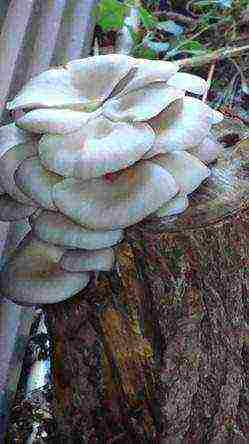
Today I want to show you how I grow mushrooms at home - oyster mushrooms.
It is very simple and not troublesome. Sow mycelium once and pick mushrooms for 3-5 years. With this method of cultivation, mushrooms turn out to be very fragrant - like grown in the forest and radically different in taste from store ones.
Each of you has the opportunity to grow eco-mushrooms in a garden plot on a stump.
I sowed mycelium for the first time 3 years ago - today is the fourth spring. This spring I decided to expand my plantations and at the same time tell everyone - because I am always asked a lot of questions.
Conifers are NOT SUITABLE for planting oyster mushrooms. The best for planting are deciduous trees: poplar, apple, cherry, oak, alder, beech, chestnut, ash, maple, poplar, birch, aspen, walnut.
Oyster mushroom grows especially well on walnut and poplar stumps.
The harder the wood, the longer the stump will last, and the more mushroom yields will grow on it.
The planting site for oyster mushrooms is a very important factor.
Oyster mushrooms do not really like places where the sun is too bright or a large open space. Therefore, it is better to plant oyster mushrooms under the trees in the garden. For example, oyster mushrooms grow well under a spreading walnut, well, or under other trees. Trees will shade the hemp with their crowns. Remember that the oyster mushroom planting site must be open to rainfall. This will save yourself the trouble of watering the mushroom garden.
You can use plots along the sheds and other structures on the north side.
Initially, I put stumps along the fence - between the building and the fence. There is a distance of about half a meter. It's enough. The main thing is not to put it under a canopy - so that the stumps are watered with rain.
To populate the mycelium, we need hardwood hemp - the size of the cuttings can be different - from 30 to 50 cm in length and 15 to 40 cm in diameter. The main thing is that the wood is healthy and there are no signs of mold infestation.
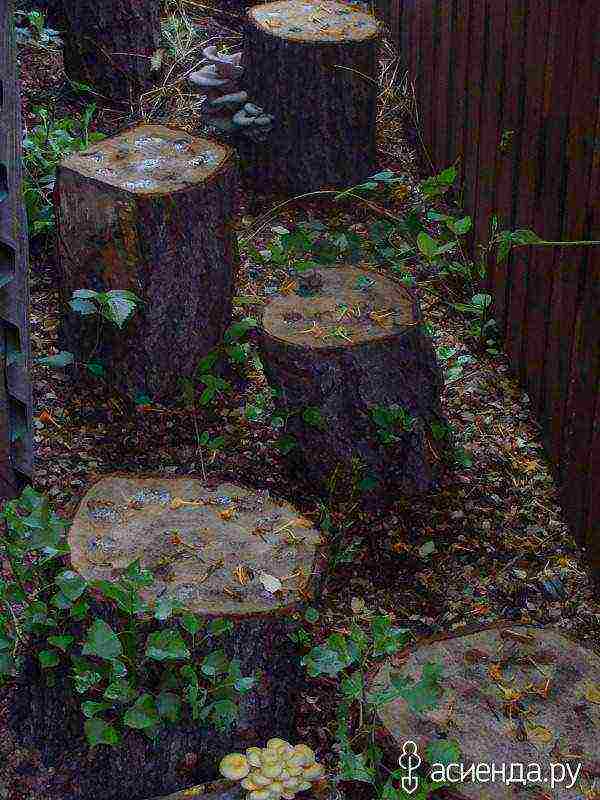
Prepare a tree stump for direct planting. It should be freshly cut, not old (dry). If the hemp is about a month old - place it in water for a day - so that it becomes wet. But, of course, it is better to use freshly sawn stumps for breeding oyster mushrooms. Then a successful result will be guaranteed.
We take the hemp, drill holes in them with a diameter of about 1-2 cm.It is possible smaller, but the smaller the diameter, the more difficult it is to fill the mycelium into it. Number in random order 6-8 holes on top and 4-6 holes on the side. IMPORTANT: The stump should stand vertically with its top up, that is, as a tree grew in nature, so put the stumps, do not change direction, turning the stumps upside down.

We fall asleep the mycelium. For convenience, we take a pencil (or other tamping device), put the mycelium into the holes, tamping it tightly with a pencil (stick, mortar, suitable in size) - do not worry, nothing will happen to the mycelium. The holes must be closed. You can close it in various ways - you can use plasticine, moss, duct tape, or, most conveniently, with a garden pitch. Some are even covered with cement. Mushrooms do not necessarily grow from these holes, they sprout inside the stump and come out anywhere
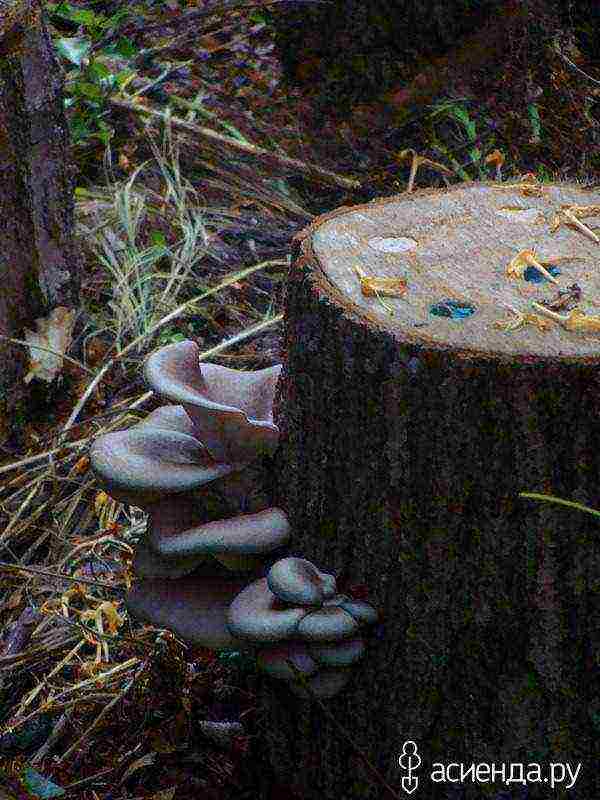
To install the stump, we dig a small hole - the depth is about 5 centimeters, put the stump in the holes and sprinkle the sides with earth. This is so that the stump is more stable and pulls moisture from the ground. Grass can grow around the stump. For more moisture, you can sprinkle around the mown grass, fallen leaves, etc., so that the soil remains moist longer.
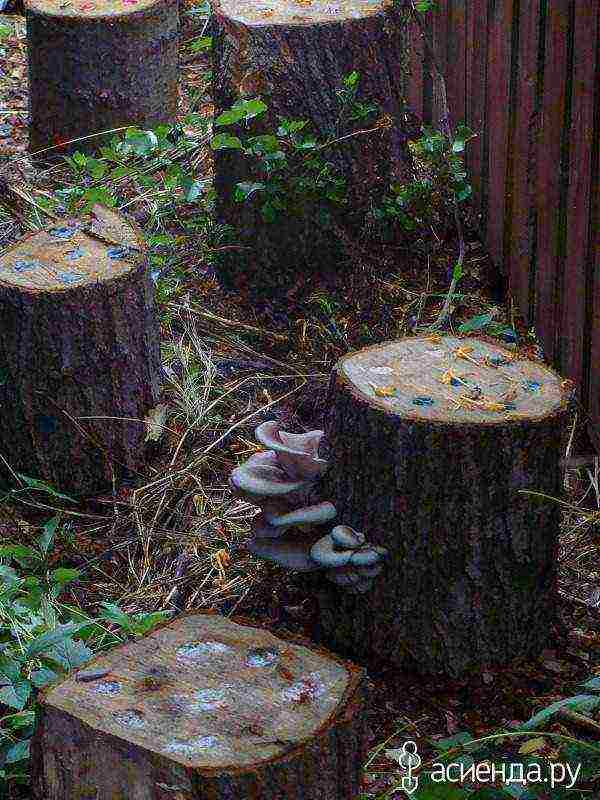
Planted, watered around and that's it. We are waiting for the harvest.
If the summer is dry, the stumps can be watered. But do not pour water directly on the stump, mycelium does not like direct ingress of water, only moisture. That is, you can water the stumps with a fine spray
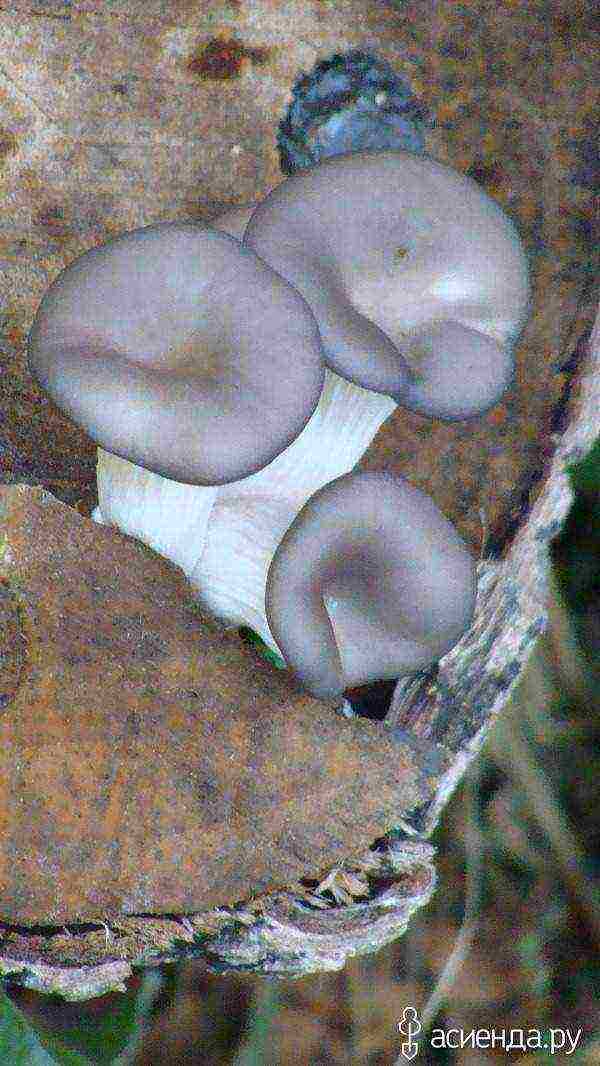
This year I decided to increase my mushroom plantation.
My husband just howled at my message that he needed to "prepare" the stumps again. By the way, it's not easy to drill them.
Buying mycelium in the society of mushroom growers, I got into conversation with their technologist (gored me with questions) and he suggested to me a less time-consuming way to populate hemp with mycelium.
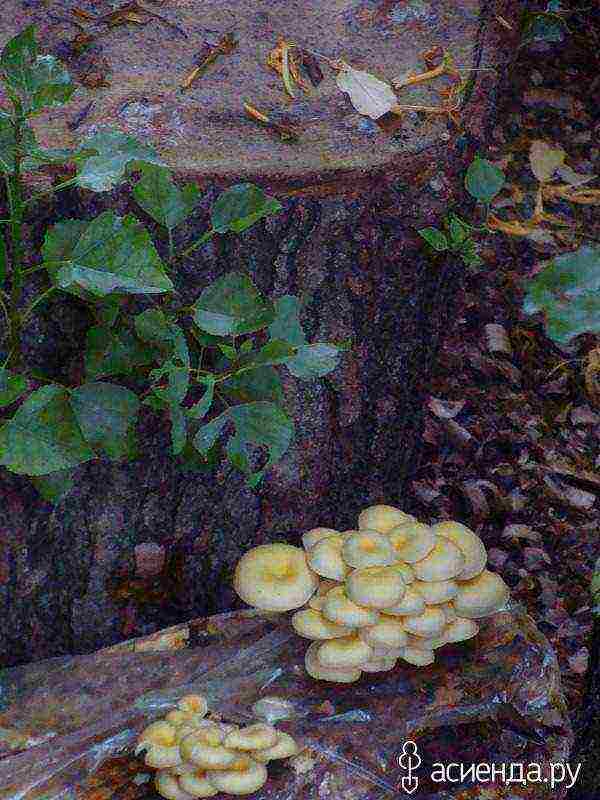
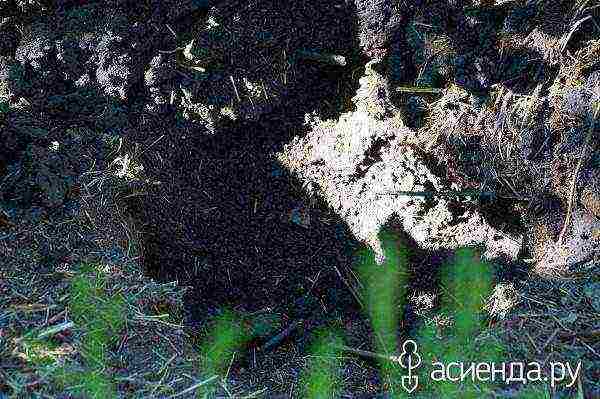
All ingenious is simple.
Digging a hole - a little less than a bayonet chipping - 15 centimeters, well 20.
The width is slightly wider than the harvested hemp.
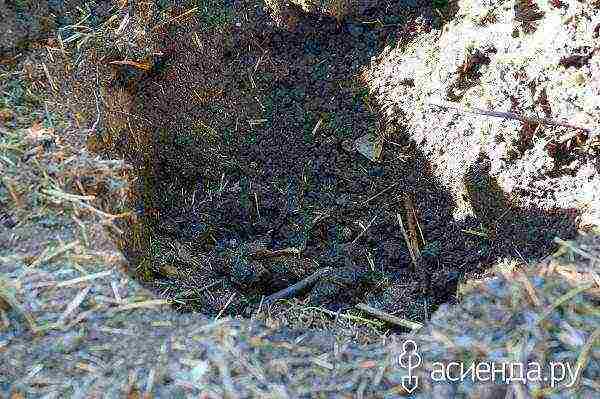
At the bottom we pour a pillow - 5 centimeters. It is possible a little more - not fundamentally.
This can be sunflower husks, dry moss, shavings or sawdust of deciduous trees.
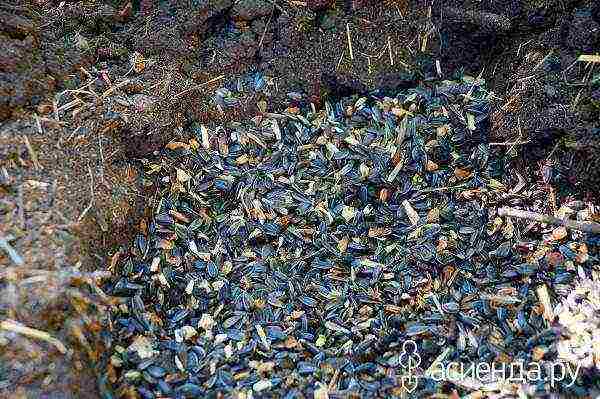
Water the hole with a pillow abundantly and pour mycelium on top - about 2 centimeters. About a handful of grain mycelium on a stump.
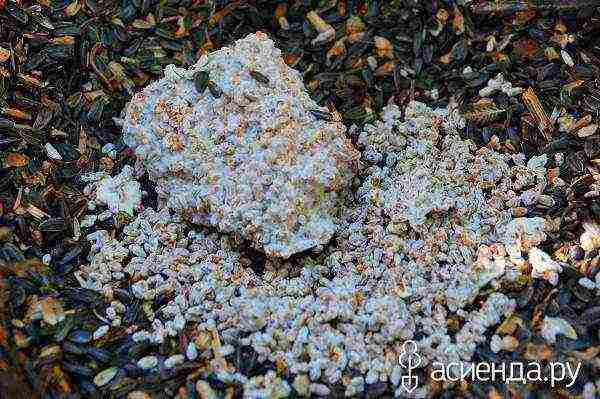
My mycelium is settled on a grain basis (wheat). I bought this mycelium from the mushroom growers' community in our city. A pack of mycelium - 2 kg costs 106 rubles today. This pack is enough for 5-6 hemp. You can search for mycelium online or search for a mushroom growing community in your area.
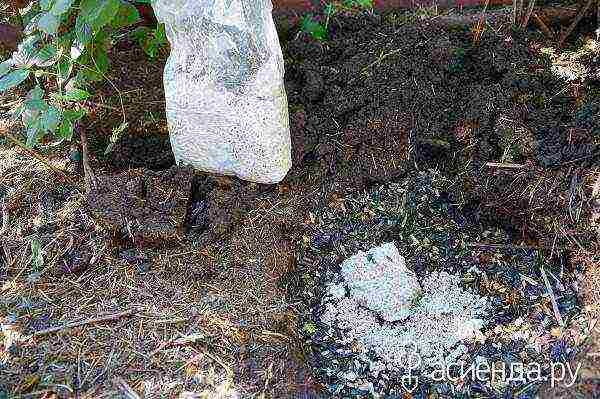
Prepared fossa
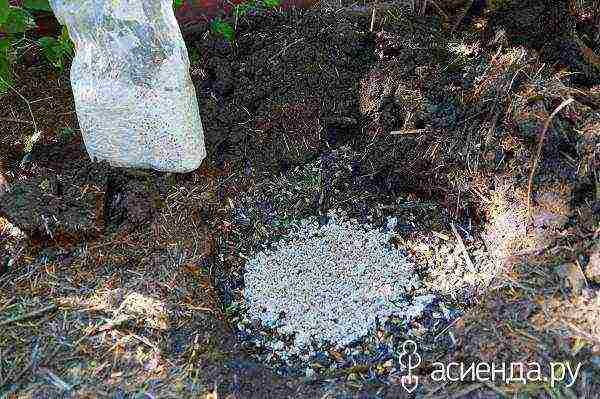
We put a stump on the mycelium.
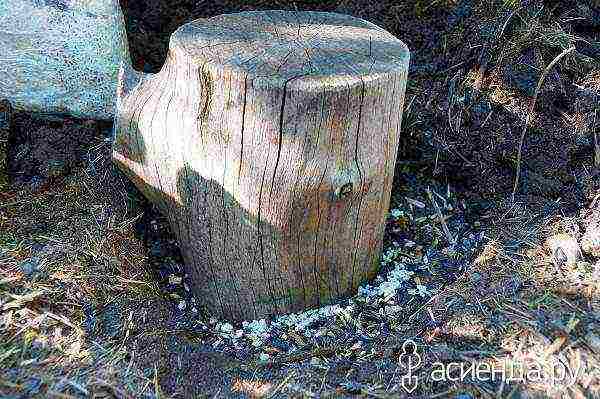
Sprinkle the sides with earth (no need to tamp) and water abundantly around.
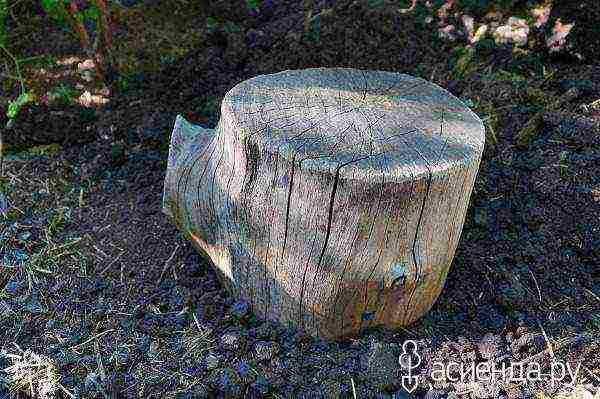
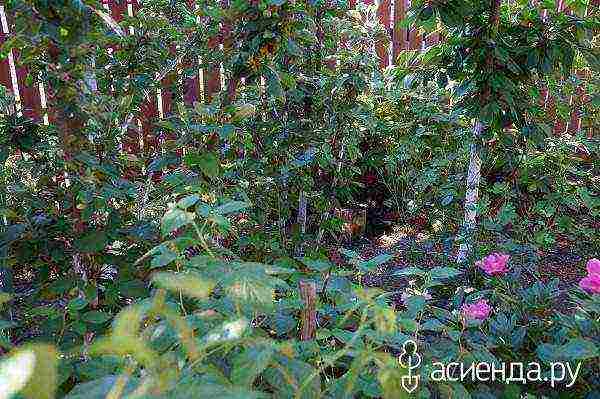
This is a general view of the place where I "planted" a stump this year - along the fence under the raspberry bushes, from above they give a shadow of the crown of large cherries.
A great place for stumps is under the spreading walnuts.
There is practically no need to look after your mushroom plantation.
Nature takes care of the good harvest itself. However, if the planting was done in the wrong place, for example, too sunny, periodic watering will be necessary.
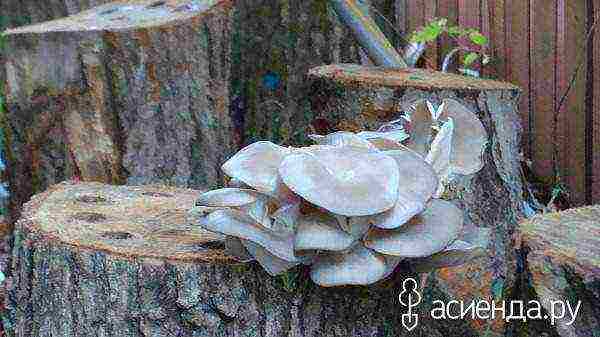
This method of growing oyster mushrooms will allow you to get a harvest of mushrooms in the same season. Moreover, you will receive mushrooms all year round - from the beginning of warm days to December (in the south, when there is no frost). Each stump will bear fruit until it completely disintegrates into parts. Such a mushroom plantation can feed you for 3-5 years, but the largest harvests occur in the second and third years. Mushrooms with 10 stumps are more than enough for one family - and we fry and pickle and preserve for the winter.
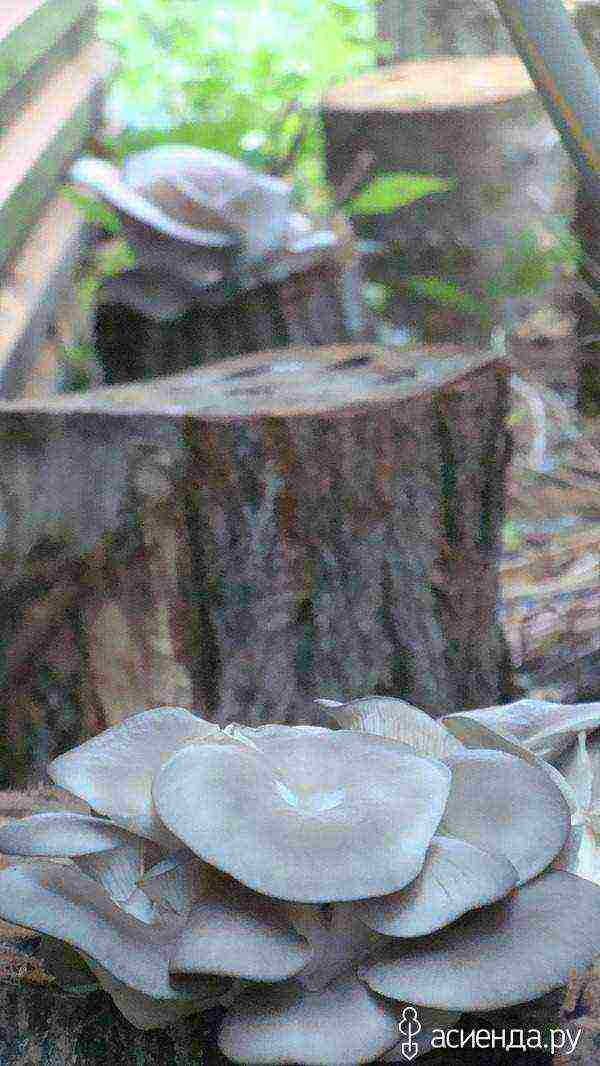
If stumps from felled trees remain on your site, you can use them, but they should be sown with mycelium only in April-May, when the temperature is above zero.
Oyster mushrooms on stumps during spring planting appear in August-September, and with a prolonged autumn, the harvest can be harvested until December. In cold regions for the winter, hemp is well covered with spruce branches, straw or foliage.
I'm not covering anything.
Now you know how to grow oyster mushrooms on stumps.
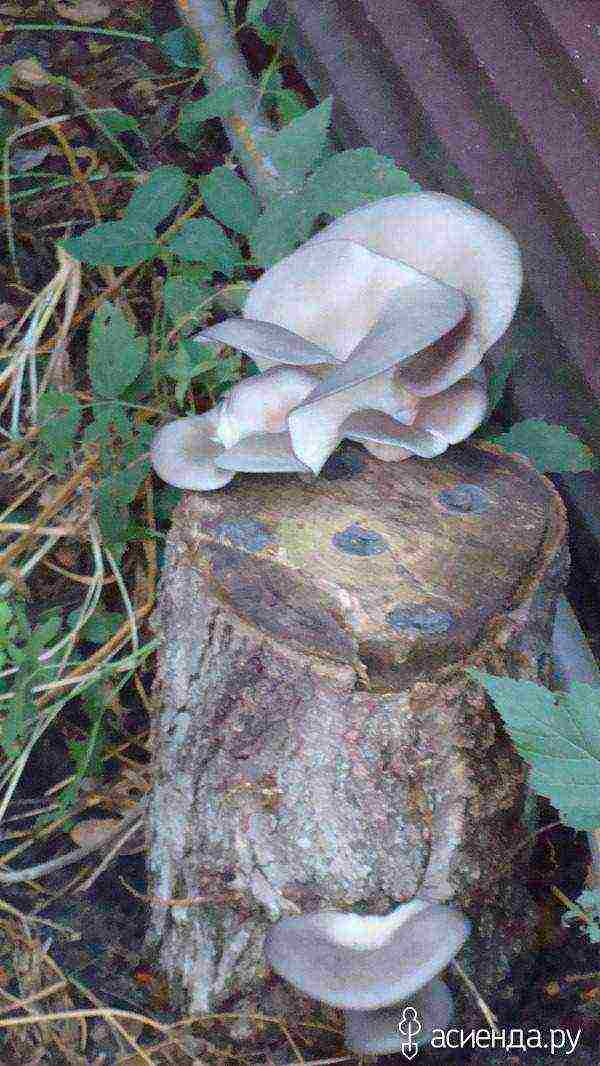

Growing oyster mushrooms is not a difficult process. It is quite possible to grow these mushrooms at home.
Mycelium (seeds)
The first step in growing oyster mushrooms will be the purchase of mycelium. It can be purchased from any mushroom growing company. Also, mycelium is sold in online stores, sending it by mail. If this is your first time growing oyster mushrooms, buy up to one kilogram of mycelium. It will become the basis for obtaining about three to four kilograms of oyster mushrooms. Storage of mycelium should be carried out in the refrigerator for a period of 2-3 months. It is impossible to freeze the mycelium.
Opening the mycelium bags must be sterile, so treat it with a disinfectant solution and use gloves.
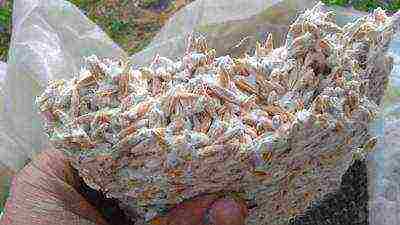
Tips for purchasing mycelium:
- Choose a trusted supplier with recommendations.
- Buy a trial batch before purchasing large quantities.
- Find out the type and strain of oyster mushrooms, the rate of mycelium growth, mold resistance, and do not forget to pay attention to the shelf life.
- Determine the temperature inside the mycelium (it is important not to overheat during delivery) - +20 degrees will be optimal.
- You shouldn't see black or green spots on the mycelium.
- The shade of the mycelium is normally bright orange. A little yellow exudate may be added to it.
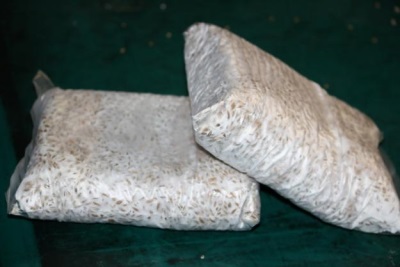 How to grow at home
How to grow at home
For self-cultivation of oyster mushrooms, two methods are used:
- Intensive
- Extensive
Intensive way
This is the name of growing mushrooms on a substrate placed in a plastic bag.
Its pluses:
- You can get a harvest of mushrooms regardless of the season.
- Mushrooms ripen quickly enough.
- You can make money by selling mushrooms.
Its cons:
- We need financial investments.
- You need a suitable room in which a certain microclimate is maintained.
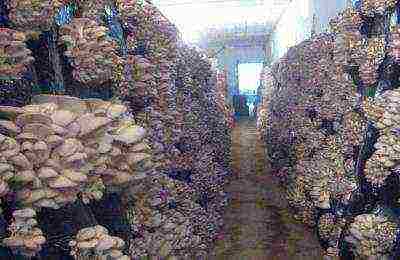 Room selection
Room selection
It is advisable to grow oyster mushrooms in a room that has:
- good thermal insulation;
- good ventilation system;
- height 3-5 meters;
- artificial lighting approximately 100 lux;
- source of clean water and sewage.
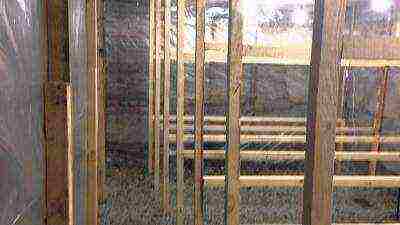
Suitable premises might be:
- Cellar;
- Basement;
- Poultry house;
- Fruit storage;
- Cowshed or pigsty;
- Granary;
- Vegetable store;
- Greenhouse;
- Garage;
- Pantry.
Remember that during fruiting on oyster mushrooms, many spores appear that can cause allergies, and therefore the room where the mushrooms are grown must be far from the living rooms.
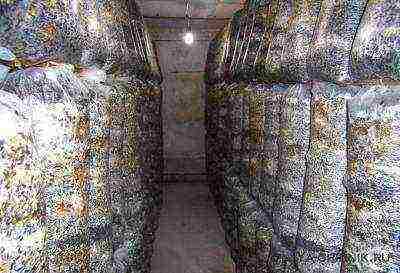 Substrate
Substrate
Next, you need to start preparing the substrate.
Oyster mushrooms are grown on:
- Sunflower husk;
- Barley straw;
- Buckwheat husk;
- Wheat straw;
- Chopped corn cobs;
- Shavings or sawdust of deciduous trees.
Beginners should choose straw, husk or husk as a substrate, since it is more difficult to grow mushrooms on sawdust and shavings. Make sure the raw materials are clean and free of mold. For a kilogram of mycelium, you need about ten kilograms of substrate. It should be crushed to obtain a fraction of 4-5 centimeters.
Thermal treatment of raw materials is also important, which will exclude its contamination and at the same time moisturize the substrate. The crushed raw material is placed in a large-volume container and completely filled with water, and then boiled for about two hours or less (the softer the raw material, the less it is boiled). The water is drained and the raw materials are cooled to + 25 + 28 degrees.
The result should be a moist substrate. To check if the raw material is waterlogged, you should squeeze it in your hands and see if water is flowing (a few drops may appear, this is permissible). Substrate treatment can be performed not only with hot water, but also with steam. Note that steam can be applied to both dry and already moistened substrates.
 Mycelium bookmark
Mycelium bookmark
The substrate is placed in polyethylene, picking up the bags so that in the end there are about five kilograms of raw materials in one bag. Pre-disinfect the bags - first they need to be washed, and then soaked for an hour in a 1-2% solution of bleach. After this treatment, start filling the bags with the substrate. After every 5-6 centimeters of raw material, put the mycelium in a bag in a layer of about 0.5 centimeters. So fill the bags layer by layer to the top, so that the last layer is the substrate.
You can also simply mix the mycelium and the substrate so that the total mass of the mycelium is 3-5 percent for the mycelium from domestic producers and 1.6-2.5 percent for the mycelium from an imported manufacturer. Bags are filled with this mixture, and then tamped tightly.
Having tied the bag, perforation must be made over its entire surface in a checkerboard pattern. Let the distance between the holes or slots, the size of which will be 1-2 centimeters, is 10-15 centimeters.
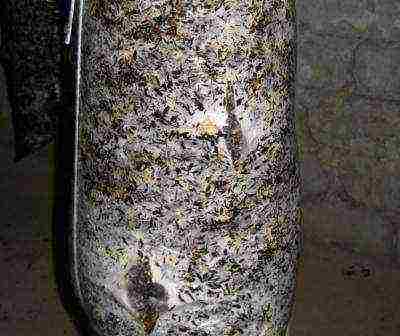 Incubation
Incubation
The next 10-25 days is the incubation period. By placing the blocks with the seeded substrate in the place where you will grow the mushrooms.
In this room, keep the temperature between 18 and 22 degrees Celsius. The room also needs to be ventilated several times daily, but make sure that flies do not get into it.
The temperature inside the bags will rise in the first three to four days, and it is important to prevent the substrate from heating more than +30 degrees so that the mycelium does not die. To lower the temperature, you can use a fan by directing it towards the blocks with mycelium. There is no need to illuminate the blocks at this stage. After three days, the filaments of the mycelium will become noticeable in the thickness of the substrate, and after about ten days they will completely fill the mushroom blocks. As a result, the blocks will become filled with a dense homogeneous mass, which will have a white color and a mushroom smell.
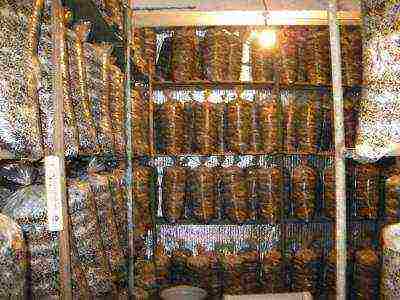 Harvesting
Harvesting
The last stage of growing oyster mushrooms is fruiting. To wait for it, immediately after the incubation period, you need to:
- Set the humidity to between 90 and 95 percent.
- Set the air temperature at + 10 + 15 degrees.
- Air the room up to four times daily.
To maintain a high level of humidity, you can start spraying the floor and walls with water, but make sure that water does not fall directly on the mushroom blocks.
If you create optimal conditions, you will soon see how the rudiments of oyster mushrooms appear in the slots. Mushrooms bear fruit for ten to fifteen days, rapidly increasing in size. When harvesting, do not cut the oyster mushrooms, but twist them out of the substrate. The color of the mushroom cap is influenced by lighting. Know that the more light falls on the mushrooms, the darker the caps of the oyster mushrooms will be.
Having collected the first crop, you should ventilate the room and wait for the second wave of the appearance of fruit bodies in about two weeks. In doing so, try to maintain the same conditions that you created for the first harvest of mushrooms. Also, after the first crop has been harvested, it is recommended to check the blocks and if they are found with mold, then take them out of the room, leaving only not infected.
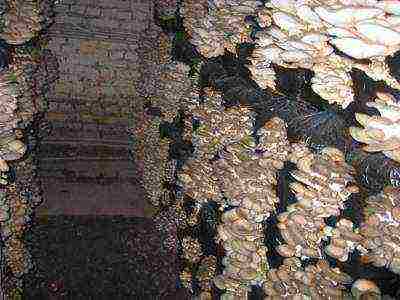
In total, mushrooms can bear fruit up to four times, but the highest yield is observed in the first two waves (they give about 75 percent). After harvesting the fourth wave, the blocks are replaced with others. Used blocks can be applied as fertilizer in the garden.
We invite you to visually familiarize yourself with the process of growing oyster mushrooms in the next video.
Ready-made mushroom blocks
A simpler option for growing oyster mushrooms at home is to buy ready-made blocks from companies specializing in the industrial cultivation of these mushrooms. Such blocks are supplemented with detailed instructions on how to successfully grow oyster mushrooms at home. The buyer only needs to place the blocks in the right room and provide the right conditions for the harvest to ripen.
 Extensive way
Extensive way
If it is not possible to obtain a suitable substrate, find a suitable room or create the conditions necessary for the fruiting of mushrooms in it, oyster mushrooms can be grown in an extensive way. It provides for growing mushrooms in the open air on stumps or logs. This method is also good for a beginner, as it requires a minimum of cash and labor costs. Its disadvantage is that such cultivation is influenced by the climatic conditions of the area, that is, seasonality is characteristic of such cultivation of oyster mushrooms.
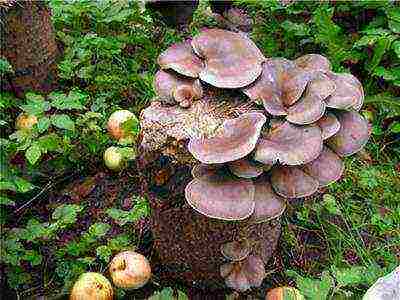 Preparing logs
Preparing logs
The preparation of logs and hemp begins at the end of winter. If there are stumps on the site left after the felling of trees, oyster mushrooms can also be grown on them, however, such stumps are sown during the period with the established above-zero temperature (April-May). If there are no such stumps, they take cuttings 30-50 cm long and 15-30 cm in diameter from ash, aspen, beech and other deciduous trees. Only healthy wood that is not infected with mold is suitable for growing mushrooms. Usually, the logs are soaked in water for several days - this will make the wood damp enough for the mycelium to develop in it. However, if the wood is not dry, then there is no need to soak it.
 How to sow mycelium
How to sow mycelium
Sowing mycelium on logs is possible in several ways:
- Place the mycelium in the holes in the stumps. Logs are drilled or filed, creating holes five to six centimeters deep and about a centimeter in diameter. It is recommended to place these holes on stumps in a checkerboard pattern. If the mycelium is grain, it should be poured into the holes, then covered with moss or sealed with adhesive tape. If the mycelium is represented by sticks, they are inserted into the holes and then sealed with plasticine.
- Place the mycelium on the end of the log. From the hemp, you need to saw off a disk two to three centimeters thick. Cover the end of the remaining stump with mycelium, place the sawn-off disk on top and attach with nails.
- Make columns from logs.On the end of the log, 100-150 grams of mycelium are laid (the layer will be about 1-2 centimeters), then the second log is laid, on which the mycelium is again poured. Then the third log is laid and sprinkled with mycelium again. Thus, you can make columns with a height of 1.5-2 meters. For their greater stability, the logs used must have a sufficiently large diameter (more than 20 cm).
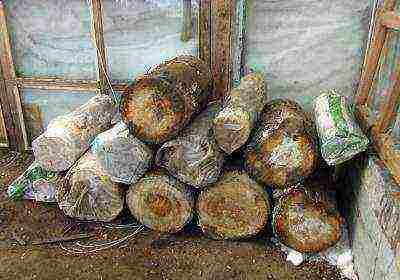
Having sown mycelium on logs, they are folded in a place where the temperature is maintained at about +15 degrees, leaving for two or three months. This can be a basement or a shed that can be regularly ventilated. If the first two methods were used for sowing, then the logs are folded horizontally one on top of the other, and then covered with burlap or perforated film. In the third method of sowing, the logs are placed vertically in several rows, filling the gaps between them with moistened straw or sawdust. From the sides, such columns are also covered with burlap or foil in order to maintain a fairly high humidity inside.
Planting logs
After a white bloom appears on the stumps, they should be planted in the ground in a shaded place. Most often this happens towards the end of spring. Pits are dug in the ground, on the bottom of which wet sawdust or wet leaves are laid. The stumps are placed in rows so that there is a distance of 35 to 50 centimeters between the logs. The cuttings are immersed in the ground for about 10-15 centimeters. Further, in case of dry weather, you should carefully water the soil around the stumps.
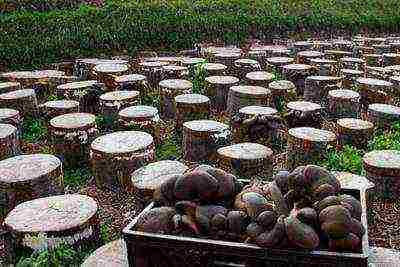 Harvesting
Harvesting
The first oyster mushrooms begin to appear in August. If the fall is protracted, then the harvest can be harvested until November. For the winter period, hemp is covered with leaves or straw. You can also cover them with spruce branches.
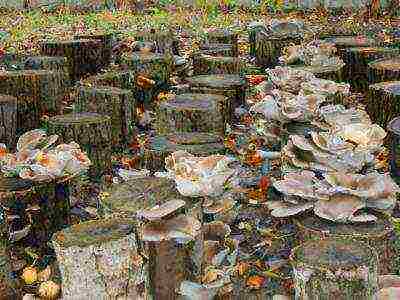
It is possible to get a mushroom harvest from such a stump plantation for up to five years. At the same time, the maximum fruiting of oyster mushrooms on stumps is noted in the second and third years.
